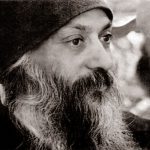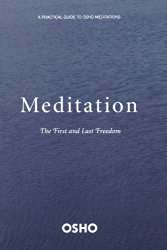Meditation-The First and Last Freedom- Osho
“Meditation- The First and Last Freedom” is based on various conversation with Osho during his live audience meetings/interviews which were recorded in period of more than 30 years. It is a really great practical guide to different Osho meditation techniques and overview of different kind of meditation.
 Osho (11 December 1931 – 19 January 1990) was a spiritual teacher born in India. He was a guru, mystic, professor of philosophy, public speaker. Osho was one of the most provocative, inspiring and many times controversial spiritual teachers. He was not afraid to touch social and political issues, religions and sexuality. Based on Wikipedia, his work includes “over 600 books translated in several languages, several thousand audio and video discourses”.
Osho (11 December 1931 – 19 January 1990) was a spiritual teacher born in India. He was a guru, mystic, professor of philosophy, public speaker. Osho was one of the most provocative, inspiring and many times controversial spiritual teachers. He was not afraid to touch social and political issues, religions and sexuality. Based on Wikipedia, his work includes “over 600 books translated in several languages, several thousand audio and video discourses”.
To find more info about Osho, listen to his audio recordings and find the complete text archive go to OSHO Library at www.osho.com
Today, just like the lightbulb, meditation is universal phenomenon- one helps illuminate our outer world, the other our inner world.
But in the process of becoming universal, many misconceptions about meditation have arisen: that it is “religious”, that it is about sitting in difficult postures, perhaps with your ankle round your neck with a holly look on your face to hide the discomfort, maybe even humming, or chanting some esoteric-sounding mantra.
If that doesn’t appeal to you, then this book is for you. Here meditation is simple, ordinary, and the natural component of a contemporary lifestyle. And increasingly, an essential component too.
– from Introduction to “Meditation- The First and Last Freedom”- Osho
 “Meditation- The First and Last Freedom” contains very practical, step-by-step guides to many of meditation techniques specially selected by or created by Osho. Some of his techniques are very different to usual just sitting still and motionless approach. The are some techniques tough by Osho called Active Meditations. They involve a beginning stage of activity, which is intense and physical and accompanied by music, before the period of silence begins. It is indeed quite unusual, not the type of meditations you heard about before. Osho explains that “you can move into passivity only when all that is there like junk has been thrown out. Anger has been thrown out, greed has been thrown out… layer upon layer, these things are there. But once you have thrown them out, you can easily slip in. There is nothing to hinder. And suddenly the bright light of Buddha land. And suddenly you are in totally different world- the world of the Lotus Law, the world of Dharma, the world of Tao.”
“Meditation- The First and Last Freedom” contains very practical, step-by-step guides to many of meditation techniques specially selected by or created by Osho. Some of his techniques are very different to usual just sitting still and motionless approach. The are some techniques tough by Osho called Active Meditations. They involve a beginning stage of activity, which is intense and physical and accompanied by music, before the period of silence begins. It is indeed quite unusual, not the type of meditations you heard about before. Osho explains that “you can move into passivity only when all that is there like junk has been thrown out. Anger has been thrown out, greed has been thrown out… layer upon layer, these things are there. But once you have thrown them out, you can easily slip in. There is nothing to hinder. And suddenly the bright light of Buddha land. And suddenly you are in totally different world- the world of the Lotus Law, the world of Dharma, the world of Tao.”
It’s a good book, I would really recommend you to read it. It’s a great introduction to meditation idea, principles and gives you overview of different techniques. Worth to get a lesson from an expert teacher 🙂
Few selected quotes:
“Meditation is witnessing. To meditate means to become a witness. Meditation is not a technique at all! This”
“Remember, that which appeals to the ego cannot help your spiritual growth.”
“Enlightenment is not an experience. It is the state where you are left absolutely alone, nothing to know. No object, however beautiful, is present. Only in that moment does your consciousness, unobstructed by any object, take a turn and move back to the source.”
“Meditation is nothing but a device to make you aware of your real self—which is not created by you, which need not be created by you, which you already are. You are born with it. You are it! It”
“These are the qualities of meditation: a really meditative person is playful; life is fun for him, life is a leela, a play. He enjoys it tremendously. He is not serious. He is relaxed.”
Where to buy it
You can get this book from: Amazon or Book Depository
Hi, and thanks for sharing this article about meditation. I don’t know Osho but I do meditate. I do brain entrainment as well. So I meditate in another way than probably Osho did.
I especially like the last quote talking about a meditative person as being playful and not serious. I like to strive after such a state of being.
Tove
I do like the brain entertainment as well, it does help to achieve the meditative state quicker. Thanks for sharing Tove!
Whether one calls it enlightenment, Tao, the world of Dharma or whatever, meditation is …. a discipline. One that requires determination, dedication and perseverance and one that must be practised until it becomes second nature, habit, in order to reap it benefits.
So difficult to get there – so easy to fall out of that habit.
I regret not having followed this one thru’. Because meditation creates a …. peace and security of mind that’s not found any other way…. How do I describe what I mean —- the world goes away and one is one with the world.
Keep up the good work! If we all practised meditation as a matter of course, this would be a far better world because you can’t do wrong to others AND meditate.
Nice words Cat, thanks for your comment!
I do agree that if we all practiced meditation the world would be better. I believe that meditation should be taught at schools.
I just started a meditation routine almost every morning and I’ve noticed a big difference in my mental state. I can focus more, I have less anxiety, I seem to sleep better. I wish I had started doing it YEARS ago.
That’s fantastic Sarah! It’s great to hear that you found meditation improving your life!